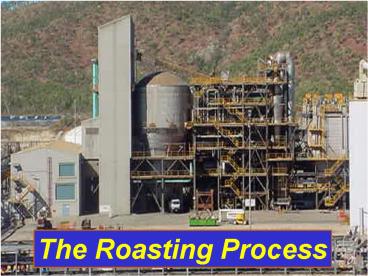The Roasting Process - PowerPoint PPT Presentation
Title: The Roasting Process
1
The Roasting Process
2
Although the zinc makes up 60 of the concentrate
it is largely in sulphide form.
3
The zinc must be converted to oxide form so that
it can be treated in the next stage of the
process - Leaching. In the Leaching Plant the
zinc is dissolved in sulphuric acid. If the zinc
is in sulphide form it cannot be dissolved in
sulphuric acid.
4
(No Transcript)
5
As a result of the roasting process.
6
Heat Energy (950oC)
The Roasting Plant produces two products. One is
an impure form of zinc oxide that is called
calcine. The other product is sulphur dioxide
gas.
7
Calcine is the end product of roasting. Even
though it looks similar to concentrate it does
not contain sulphur.
- In addition to the zinc it still contains
- iron
- silica
- calcium
- copper
- cobalt and
- cadmium.
How can we remove these elements? More Roasting?
No, this wont work!
8
The zinc in the calcine is present in four forms.
6 Zinc Sulphate
13 Zinc Ferrite
Zinc Oxide 80
A certain amount of the zinc is combined with
iron, called zinc ferrite. A small amount of
zinc sulphide is also present as a result of
incomplete roasting.
9
(No Transcript)
10
Summary
- In the Roasting Process most of the zinc
sulphide - is converted into zinc oxide.
- The sulphur is removed from the zinc sulphide
and - is liberated as sulphur dioxide gas.
- The end product of Roasting is called calcine.
This - contains zinc oxide and zinc sulphate which
are - recoverable in the Leaching Plant.
- The zinc ferrite and zinc sulphide cannot be
- dissolved.
PowerShow.com is a leading presentation sharing website. It has millions of presentations already uploaded and available with 1,000s more being uploaded by its users every day. Whatever your area of interest, here you’ll be able to find and view presentations you’ll love and possibly download. And, best of all, it is completely free and easy to use.
You might even have a presentation you’d like to share with others. If so, just upload it to PowerShow.com. We’ll convert it to an HTML5 slideshow that includes all the media types you’ve already added: audio, video, music, pictures, animations and transition effects. Then you can share it with your target audience as well as PowerShow.com’s millions of monthly visitors. And, again, it’s all free.
About the Developers
PowerShow.com is brought to you by CrystalGraphics, the award-winning developer and market-leading publisher of rich-media enhancement products for presentations. Our product offerings include millions of PowerPoint templates, diagrams, animated 3D characters and more.































